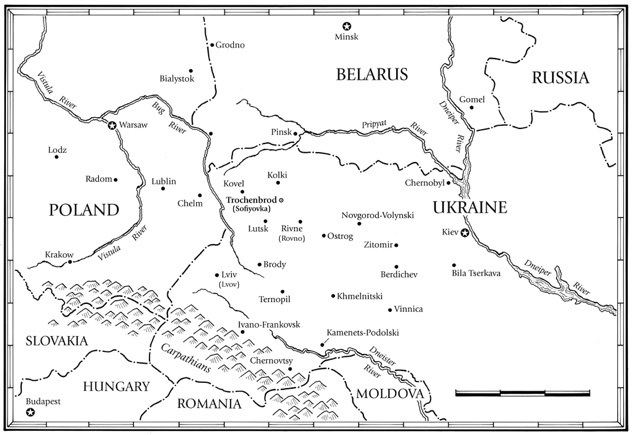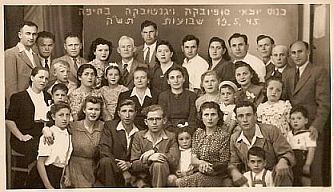Website A Lost History Local time Saturday 9:40 AM | Area 6.99 km² Named for Maria Feodorovna | |
 | ||
Weather 3°C, Wind W at 10 km/h, 66% Humidity | ||
Trochenbrod documentary trailer
Trochenbrod or Trohinbrod, also in Polish: Zofjówka (pl), or in Russian: Софиевка (Sofievka), in Ukrainian: Трохимбрід (Trokhymbrid), Hebrew: טרוכנברוד, was an exclusively Jewish shtetl – a small town, with an area of 1,728 acres (6.99 km2) – located in the gmina Silno, powiat Łuck of the Wołyń Voivodeship, in the Second Polish Republic. Following the invasion of Poland by Nazi Germany and the Soviet invasion of Poland in September 1939, Zofjówka (official Polish name) was renamed in Russian and incorporated into the new Volyn Oblast of the UkSSR. Two years later, at the start of Operation Barbarossa in 1941, it was annexed by Nazi Germany into the Reichskommissariat Ukraine under a new Germanized name. Trochenbrod (Zofjówka) was completely eradicated in the course of German occupation and the ensuing Holocaust. The town used to be situated about 30 kilometres (19 mi) northeast of Łuck in the Kresy macroregion (present-day western Ukraine). The nearest villages of today are Yaromel (Яромель) and Klubochyn (Клубочин).
Contents
- Trochenbrod documentary trailer
- the heavens are empty by avrom bendavid val about trochenbrod ukraine
- History
- The Holocaust
- Trochenbrod in literature
- Sede also
- References

The original settlement inhabited entirely by Jews, was named after Sophie, a Württemberg princess (1759–1828) married to the Tsar of Russia Paul I (hence Sofievka or Zofjówka). She donated a parcel of land for the Jewish settlement in the Russian Partition after the conquest of the Polish–Lithuanian Commonwealth (see new Pale of Settlement district).
the heavens are empty by avrom bendavid val about trochenbrod ukraine
History

Sofievka (Trochenbrod) was founded in 1835, after the November Uprising, initially as a farming colony for the dispossessed Jews, and with time developed into a small town. The population grew from around 1,200 inhabitants (235 families) in 1889, to 1,580 in 1897 according to Jewish archives. In the Second Polish Republic, the number of inhabitants reached 4,000. The name Trochenbrod in Yiddish stands for "Dry Bread" or "Bread without Butter" (German: Trockenbrod).

Towards the end of World War I, during the Polish–Soviet War, the forces of the re-emerging sovereign Poland and the Red Army fought over the town. It was ceded to Poland in the Peace of Riga signed with Vladimir Lenin, and it became part of the Wołyń Voivodeship in the Kresy Borderlands. Most of the population were engaged in agriculture, dairy farming and tanning.

There were seven synagogues in Trochenbrod, including three big ones. In 1939, the town, along with the rest of Kresy, was invaded by the Soviet Union (see Molotov–Ribbentrop Pact). The rabbi at that time was Rabbi Gershon Weissmann. The Communists exiled him to Siberia after accusing him of being involved in underground salt trading.
The Holocaust

After Nazi Germany attacked the Soviet forces in eastern Poland in June 1941, the new German administration established a Jewish ghetto at Trochenbrod, confining there also Jews from nearby villages and towns. The Ghetto was liquidated in August and September 1942 in a series of massacres by uniformed police. Most of the Jews of Trochenbrod as well as of the neighbouring village Lozisht (Ignatówka in Polish) were murdered by the local collaborators, consisting mostly of the Ukrainian Auxiliary Police who rounded up the prisoners in the presence of only a few German SS men. According to Virtual Shtetl over 5,000 Jews were massacred, including 3,500 from Zofiówka and 1,200 from Ignatówka among other nearby settlements.

Fewer than 200 Jews managed to escape death by fleeing into the forest. The Soviet partisans hiding in the nearby village of Klubochyn assisted some 150 survivors. Some Jews joined the resistance in the region and took up partisan actions against the Nazis. The village was totally destroyed and burnt down in 1942, and subsequently leveled out after World War II in the Soviet Ukraine. Now only fields and a forest can be found there, and an ominous flatland with an aimless country road running through it. One Ukrainian family in Klubochyn was executed for assisting Jews. After the end of World War II, the Jewish survivors from Trochimbrod, numbering between 33, and 40, lived in the area of nearby Lutsk.
Trochenbrod in literature

A fictionalized historical portrayal of the shtetl life at Trachimbrod was featured in the 2002 non-fiction novel Everything Is Illuminated by Jonathan Safran Foer as well as in the 2005 film based on the novel.

Safran Foer, whose father and grandfather came from Trochenbrod, depicts fictionalized events in the village beginning in 1791 – the year in which the shtetl was first named – until 1942, when it was destroyed in the war. Safran Foer's modern-day protagonist (who goes by the author's name and also by the name "Hero", or "the Collector" in the film version) comes to contemporary Ukraine to look for a woman named Augustine, who saved his grandfather in the war. The novel was criticized by a reviewer from Ukraine published by The Prague Post online.
